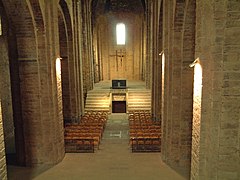Church of Sant Vicenç

TheChurch of Sant Vicenç of Cardona(Catalan:Església de Sant Vicenç de Cardona) is aLombardRomanesquechurch inCardona,Catalonia,Spain. It was built between the years 1019 and 1040,[1]and is located in the center of theCastle of Cardona.
History
[edit]The church has its origins in the chapel of the Castle of Cardona, which was property of House of theViscountsofOsona.(The family later took theirnamefrom this castle.) This first church was documented in 980, and was protected under the patronage of the viscounts.
During the 11th century, a number of stone churches—several as a part ofBenedictinemonastic complexes—began to be built in the area, though the earliest of these churches still had wooden trusses supporting the roofs. The church of St. Vincent was begun about 1019 and consecrated in 1040, under the patronage of viscount Bermon I.
Architecture
[edit]
The church was built as a showpiece, and is impressive for its scale—with a height of more than 19 m (62 ft). Itsbuilding materialiscut stone,and the stonework is both austere and sophisticated, given the uniform size of the cut blocks and the quality of the masonry.
Interior
[edit]In the interior, abarrel vaultof stone covers the nave, which is flanked by two side-aisles. Along the nave, threetransverse arches,which are evenly spaced, add support. Their arches continue down the piers as pilasters, complete with capitals at the springing of the arch. Rounded arches, supported by piers, open into the side aisles, which are covered with stone groin vaults. Above the nave arcade, small rounded lancet-shaped windows pierce the stone walls. The windows are evenly spaced over the arch openings.
Adomeresting on squinches is over the crossing in front of the altar. The dome has anoculusopening at the top and small rounded lancet windows in the drum. This is the first known example of a basilica-plan church built with a dome in Western Europe, which represents the synthesis of sacred-building and meeting-hall typologies in the Roman tradition.[1]

At the crossing, the nave meets thetransept,which is actually slightly wider than the nave. The transept, however, is short, barely emerging from the sides of the church, but still giving the structure a typical cruciform plan. Beyond it, the aisles of the church terminate in threeapses,each sized according to the size of the aisle.
Exterior
[edit]From afar, the church's exterior is notable for the prevailing regularity of straight lines, excepting the three semicircular apses. Above the whole rises an octagonallantern tower,which corresponds to the interior dome.
Paintings
[edit]Theporticoof the church was once covered withmurals.Fragments from the three central vaults (of five) were restored in 1960 and are now displayed at theMuseu Nacional d'Art de Catalunya(MNAC) inBarcelona.Though the portico was built with the church in the 11th century, the frescoes themselves date to the 12th century.[2]
Gallery
[edit]-
Atrium vault frescoes at MNAC
-
Atrium
-
The Defense of Girona
-
The atrium today
-
Remains of thecloister
-
Church crypt
-
Tomb of the Dukes of Cardona
-
Tomb
-
Apse. Note the extensive use ofLombard bands
-
Castle of Cardona
See also
[edit]References
[edit]- ^abCirici, Alexandre (1975).L'Arquitectura Catalana(in Catalan). Barcelona: Editorial Teide. pp. 131–133.ISBN84-307-8305-9.
"La primera basílica amb cúpola que es coneix en tots els dominis de l'Església Romana és la de Sant Vicenç de Cardona, edificada del 1019 al 1040
- ^"Maiestas Domini and Tetramorph from Cardona".Museu Nacional d'Art de Catalunya.Retrieved4 May2016.
- Stokstad, Marilyn (2004).Medieval Art(2nd ed.). Boulder: Westview Press.ISBN0-8133-3681-3.
- Luttikhuizen; Verkerk, eds. (2006).Snyder's Medieval Art(2nd ed.). Englewood Cliffs:Prentice Hall.ISBN978-0-13-192970-8.
External links
[edit] Media related toSant Vicenç de Cardonaat Wikimedia Commons
Media related toSant Vicenç de Cardonaat Wikimedia Commons










